Slaughterhouses are a complex of rooms in which animals are slaughtered in accordance with technical regulations and hygiene, resulting in fresh carcasses (meat) and edible internal organs of the abdominal cavity and chest. Slaughterhouses should be created in such a way as to produce healthy meat and not pollute the environment from the other side. The lack of standard slaughterhouses with international standards has led to an increase in meat waste, and the existing slaughterhouses do not meet the standards and do not meet the requirements of the city of Kabul. The number of slaughterhouses in Afghanistan is limited, they were built in major cities such as Kabul, Mazar-I-Sharif, Kunduz, Herat and Jalalabad. In this study, methods such as visiting, interviewing, observing, and using questionnaires were used to study the situation in the abattoirs in Kabul. As a result, it was noted that the state of the slaughterhouses is unusual, and the slaughterhouses in Kabul are located in residential and urban areas, which pollute the environment with blood and excess carcasses, and the movement of animals is also a concern in the city. All these problems are related to the existence of livestock markets in the city or in the districts of Kabul, such as Nahas in Chaman-e-Babrak, Chaman-e-Khuzuri, in the company and so on.
Keywords: slaughterhouse, animals, butcher, Kabul, Afghanistan.
Бойни — это комплекс помещений, в которых животные забиваются в соответствии с техническими регламентами и гигиеной, в результате чего получаются свежие туши (мясо) и съедобные внутренние органы брюшной полости и грудной клетки. Бойни должны быть созданы таким образом, чтобы производить здоровое мясо и не загрязнять окружающую среду с другой стороны. Отсутствие стандартных бойней с международными стандартами привело к увеличению отходов мяса, а существующие бойни не соответствуют стандартам и не отвечают требованиям города Кабула. Количество бойней в Афганистане ограничено, они были построены в крупных городах, таких как Кабул, Мазари-Шариф, Кундуз, Герат и Джелалабад. В этом исследовании для изучения ситуации на скотобойнях в Кабуле использовались такие методы, как посещение, опрос, наблюдение и использование анкет. В результате было замечено, что состояние боен нестандартно, а также бойни в Кабуле расположены в жилых и городских районах, которые загрязняют окружающую среду кровью и избыточной частью туш, а перемещение животных также вызывает беспокойство, в городе. Все эти проблемы связаны с существованием животноводческих рынков в городе или в районах Кабула, таких как Нахас в Чаман-э-Бабрак, Чаман-э-Хузури, в компании и так далее.
Ключевые слова: бойня, животные, мясник, Кабул, Афганистан.
Among the parameters or factors that play essential role in the preparation of healthy food, especially meat, are the standard centers for the slaughter of animals. If a healthy, disease-free animal is brought to these centers for slaughter, processing, storage, distribution, and consumption, but the slaughterhouse is not standard, it is possible that in all of the above steps, products obtained from animals for feeding are exposed to various disease agents. It also causes heavy economic, social and psychological damages to society. Slaughtering animals in slaughterhouses are a legal, moral and cultural act that shows the observance of the new principles and foundations of urban culture. Psychologically, the slaughter of animals in public places and in front of the eyes of children and infants has not taken place and has not had a negative impact on their psyche and will not cause violent behaviors in these people in the future Ahmad and Ahmadi (2016). Preventing the killing of animals in different parts of the city, preventing the hanging of carcasses, as well as preventing the shedding of blood and waste from their slaughter, will be good for having a clean and beautiful city. Standard killings can prevent serious threats to public health and the dangers of public health; in addition to preventing environmental pollution, it prevents the accumulation of stray animals, insects and rodents, which plays an important role in preventing the spread and transmission of various infectious diseases and also reduces the waste of animal products, especially animal by-products at the time of slaughter.
The possibility of secondary contamination of meat is possible throughout the slaughter of animals, from the skinning of the animal to the evacuation of internal organs and all stages of slaughter. After killing the pathogens around the meat, including knife contamination, contamination of the slaughterhouse, contamination of the butcher's hands, microorganisms of the digestive system, etc, can easily turn the product into contaminated and unhealthy meat Murtazawi and Mahoong(1381). When the animals are slaughtered, the abdomen is then opened, and the internal organs must be removed, and the empty limbs of the breasts must be removed, and then the carcasses are washed with clean water and hung in an atrium where the temperature reaches 5 degrees Celsius. It should be remembered that in the first step, the skin of slaughtered animals is pulled, because its internal organs cannot be touched without being peeled. In order to cool the meat for the next steps, it is necessary to put the carcasses of the animals in the refrigerators and transporting the carcasses of the animals completely is also a difficult task. In the development of meat preparation stages, it is necessary to cut it into pieces, and according to market demand, animal carcasses with excellent nature and quality should be cut into pieces, although they are distributed to wholesalers in large pieces Dawlat Khah (1387). The above issues are practiced in a standard slaughterhouse.
Materials and methods of work
To collect information, the method used in this research is the method of visit, interview, observation and use of questionnaires.
Introducing the research area
Kabul is the capital and the most populous city of Afghanistan and its area is about 275 square kilometers. This province consists of 14 districts and 22 regions Central statistic (1393). The population of Kabul is currently estimated at more than 6 million. The randomly selected research areas in this city are listed in Table (1).
Table 1
Visited areas in Kabul city
|
Numbers |
Regions |
Numbers of Bucher |
|
1 |
Chehlstoon |
6 |
|
2 |
Darulamaan |
5 |
|
3 |
Cynamapameer |
9 |
|
4 |
Kota — e –Sangi |
8 |
|
5 |
Kairkhana |
3 |
|
6 |
Arzanqimat |
6 |
|
7 |
Poolsurkh |
9 |
|
8 |
Frooshgah |
3 |
|
9 |
Airport street |
5 |
Analysis
Raw figures were collected through observation, questionnaire, visit, interview and study; the raw data process is presented in a simple way using Microsoft Word program.
Result and Discussion
In Afghanistan, especially in Kabul, there are two major sources for animal slaughter:
- Slaughterhouses
- Butchery
In certain cases, some families, hoteliers, or during religious ceremonies, the general public also slaughters animals.
Slaughterhouses
1) Slaughterhouse of the Ministry of Defense
When Ministry of Defense slaughterhouse was built, there were no residential houses around it and there was a Nakhas (Place for selling animals) next to it, and at that time it was a suitable place to build such facilities, but now that Kabul city has developed, it is not suitable place for killing animals. The construction of this slaughterhouse was standard, but due to the wars, some of these buildings have been destroyed, which has caused problems in the killing process, for instance live animals in a specific place called the station are brought down from the vehicle to the cages and transferred to Waited chamber for 24–48 hours quarantine Figure (1).

Fig. 1. Waiting place and quarantine chamber of the Ministry of Defense slaughterhouse
After quarantine, the animals are examined by a veterinarian, and the sick animals are separated from the healthy ones and returned or destroyed. The number of these animals reaches 30–50 sick animals per day. At the same place, there is a scale that is currently inactive and is used to weigh live animals Figure (2).
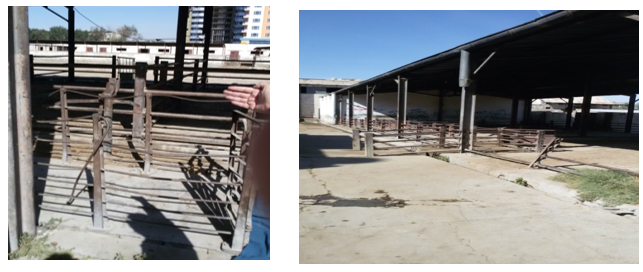
Fig. 2. Rail line and passive scales weighing live animals
There are separate slaughterhouses for slaughtering cattle, buffaloes, and sheep, goats in the Ministry of Defense slaughterhouse which produces 12,000 kilograms of meat per day. From the beginning of the 15 November to 15 December, 50–100 cows and buffaloes are slaughtered, and in other months of the year, 700–800 goats and sheep are slaughtered daily.
In the past, the method of slaughter was as follows: after the animal was transferred to the slaughterhouse, 100 sheep or goats were placed at the slaughterhouse and slaughter performed by a blade called the Takbir blade. Because Afghanistan is a traditional country, this method of killing has disappeared and is now carried out by hand in a non-standard way, and even irresponsible people such as contractors walk freely around the slaughterhouse. The people who slaughter animals are also unprofessional and wear ordinary clothes (Figure 3), and no restrictions are imposed in this regard or, if any, are not considered in practice.
The number of people who kill animals in the collection is called butchers and reaches 40. None of them is not equipped with work clothes and they do it in an unhealthy way and without considering the hygienic conditions. When the slaughter is over, the slaughtered animals are hung and peeling begins, and the internal organs of the abdomen and chest are removed from the carcass at the same place and placed on one side of the slaughterhouse.
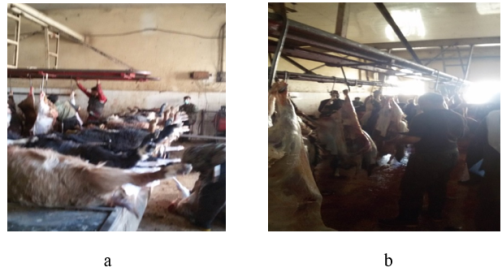
Fig. 3. (a) — Inside the slaughterhouse, (b) — Peeling operation
The carcass is transported by hand-operated rail cranes to a cold storage facility for weighting, not cooling, and is transported to consumption areas by refrigerated or closed-door Department of Defense vehicles (Figure 4).
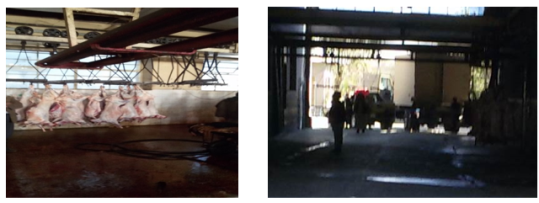
Fig. 4. Transfer of carcasses to loading in refrigerated vehicles of the Ministry of Defense
It is worth mentioning that during these works, based on the observations made, no health measures or hygiene were considered, and all their statements, especially from Dr. Veterinarian, who was in charge of health, were theoretical and nothing was seen in practice.
There are no standard measures for the disposal of waste and excess materials; only these materials were collected at a place of facilities in a part of the ruins and then transported by a military vehicle to the areas around Kabul such as Shineh, Batkhak and Kamri related to Bagrami district of Kabul. Is given in Figure (5).
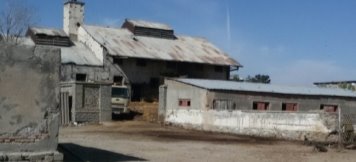
Fig. 5. The place of collecting waste and loading it in the slaughterhouse of the Ministry of Defense
The mentioned slaughterhouse has 6 barns or house reserves and only three sections of it are active, which is free of meat or meat products, and the other three sections are completely inactive, and entry to this section was not allowed.
In the sanitation section, especially disinfection inside the slaughterhouse, corridors, water pipes (furrows), chlorine disinfectant is used, which is available in a plastic barrel with a volume of 80–100 liters behind the slaughterhouse gate, and according to them, daily it is used while it may be used once a week. An anti-insect and parasite spice called Icon is also used to cleanse and kill the organisms mentioned inside the stables, pens and other animal habitats without considering the negative effects of these spices. In this slaughterhouse, ponds for water and water treatment are also available and active, but there is no standard and the remaining water or waste of these treatment plants is dumped into Kabul which pollutes the environment around which millions of people live and move around daily. In the future, the slaughterhouses of this slaughterhouse are to be moved to the Pul-e-Charkhi area, and only meat cages or storage houses will remain in the existing location, and according to the officials of this slaughterhouse, work is underway on it and its surroundings are completed.
2) The slaughterhouse of the Karta-e-Mamorin
According to the findings of this study, another slaughterhouse in Kabul is located in the Karta-e-Mamorin of the fifth district of Kabul, which is originally a private slaughterhouse and has a contract with the Ministry of Interior and provides the necessary meat daily. Despite repeated calls, official prevented from meeting and being, and he declined to provide further information. Because this slaughterhouse is in a substandard situation and the slaughter conditions in it are also non-standard, and the residents of that area complained about it because he is a powerful person and even the government is not able to block it or move it to another place. Karta-e-Mamorin’s slaughterhouse is not a suitable place for slaughterhouse at all. This slaughterhouse operates for the Ministry of Interior and slaughters (20–50) buffaloes and (200–300) sheep per day on the day of slaughter. There is also a building nearby to keep 500–1000 sheep and other animals. The slaughterhouse officials emphasize that they transfer all the waste and blood to Paghman district after the slaughter. Most importantly, in some cases, the buffaloes escaped from the butcher's knife, causing harassment and even injury to locals. ( http://8am. af/1395/04/28/kabul-municipality-cleaning-markets-the-slaughter house )
Company area slaughterhouse
Other private slaughterhouses are located in the Kabul, Company area, slaughtering various animals for money for butchers, hoteliers, restaurants, and others, averaging 20 buffaloes, 10 cows, and 20 sheep a day are slaughtered, and taken from the slaughter and expulsion of internal organs of a cow and buffalo in the amount of 200–300 Afghanis and from the slaughter of a sheep and expulsion of internal organs in the amount of 50–70 Afghanis. The whole process of slaughtering, including all stages such as pre-slaughter, slaughter, post-slaughter, and general hygiene of slaughter and slaughterhouse, is non-standard and contrary to all slaughterhouse principles. authority and the government, especially the municipality, the Department of Animal Health of the Ministry of Agriculture, Irrigation and Livestock and the Ministry of Public Health have no control, inspection and control over these slaughterhouses. In the slaughterhouse located in the Kampany area of Kabul city, animals are transported to the slaughterhouse with beatings and suffering, and without any special measures. Before the animal dies and all blood is expelled from, the animal's head and legs are amputated and the act of emptying the thoracic and abdominal cavities begins.

Fig. 6. Transfer of animals to the slaughterhouse with beatings and torture
In this slaughterhouse, the slaughter begins without restraining or closing the animal, even when some animals are re-trained with their necks cut in half (Figure 7). In many cases, especially buffaloes, they escape from under the knife and cause harassment or injury to the local people, which is completely against all the principles of killing, and this is contrary to the statements of Ahmad and Ahmadi (2016) regarding the laws related to transportation and the animals are transported to the slaughterhouse for slaughter.
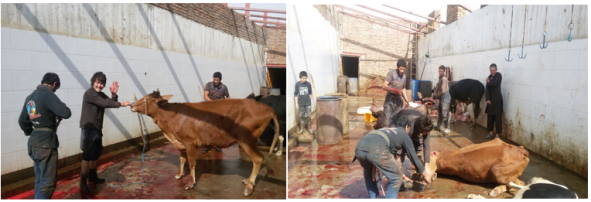
Fig. 7. Half-cut neck and re-laying the animal for slaughter
In this slaughterhouse, hygiene measures are not considered and the slaughterhouses perform this operation without special clothing for slaughter figure (8).
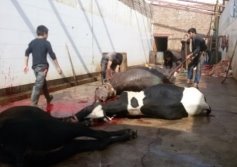
Fig. 8. Slaughterhouses without standard clothes in Kabul Company Abattoir
The slaughterhouse is located near the public road and among residential houses. The slaughterhouse has a public gate that is about 5–6 meters long and more than 4 meters high and is open all day and no restrictions have been imposed on movement. The location of the slaughter of various animals in the slaughterhouse is also unknown. The walls of slaughterhouses are made of materials such as baked clay and cement, as well as mud and raw clay. The height of the walls is about 3–4 meters and half of this height is tiled Figure (9). The floor of the slaughterhouse is cement and has a slope so that blood flows to the furrow with water. The blood collected after the slaughter of animals is either taken to agricultural fields or thrown out and not used. The roof of the slaughterhouse is sometimes semi-open, which is made of wood, planks, loam, or tarpaulins.
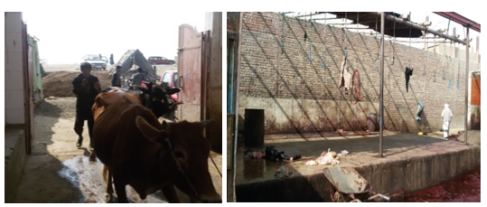
Fig. 9. Building, location and gate of non-standard slaughterhouses in Kabul company area
This slaughterhouse does not have any special place to keep animals before slaughter, such as a place for bathing slaughterers, a room for official work, a place for different parts of the animal body, not enough water and electricity, and people are working in this slaughterhouse who does not know about any regulation of slaughtering of animal. Most of them are illiterate and have not received any training from the relevant authorities. Figure (10)
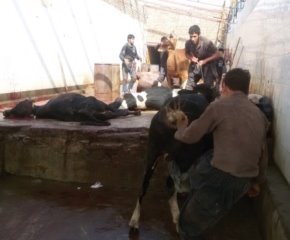
Fig. 10. Slaughterhouses collide with animals before slaughter
After the slaughter is over, the internal organs, especially the digestive system of the animals, are separated from the carcass and all its contents are collected on one side of the slaughterhouse, which is very close to the carcass and can come into contact with the carcass at any time (11).
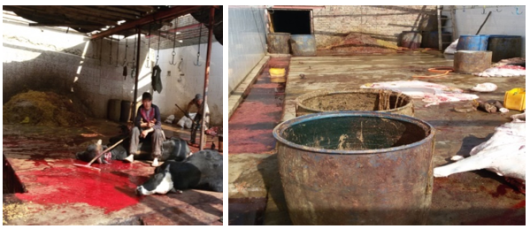
Fig. 11. The site of accumulation of rumen contents and other contaminants near animal carcasses
In this slaughterhouse, very simple and basic tools are used to clean carcasses and meat, and no serious attention is paid to its preservation (Figure 12).
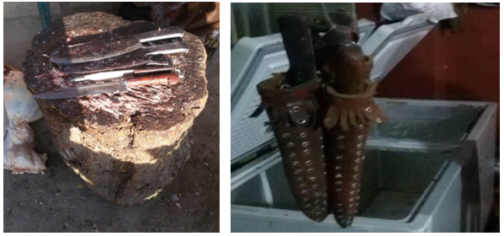
Fig. 12. Non-sterilized equipment for cutting of meat
In the slaughterhouses located in the company, the animals are slaughtered without restrain them, and slaughter is still done in front of the alive animal, which is against the conditions of Islamic slaughter (Figure 13).
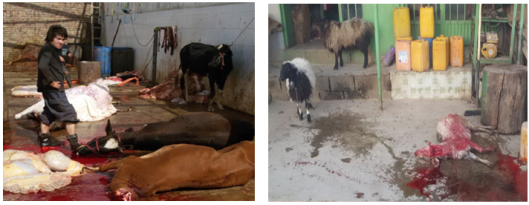
Fig. 13. Slaughter or slaughter in front of the eyes of live animals
The slaughterhouses in Kabul are limited in number and are located in situations that are completely contrary to the norms and standards of slaughterhouses. The number of these slaughterhouses does not reach more than 5 slaughterhouses, of which only the government has control over two slaughterhouses, one of which belongs to the Ministry of Defense and the other to the Ministry of Interior which provide animal meat such as beef, buffalo, mutton and goat, which in principle, it is a personal slaughterhouse. There are also some small slaughterhouses in the alleys of Kabul where various animals are secretly slaughtered which pollutes the environment and are deemed to be source of infection in the environment, and also sells contaminated meat from sick and diseased animals. The current situation of this slaughterhouses are in contradiction with the theories and definitions of Glustani (1369) and Maqami (1386) and the report of DCA Institute (1394) which explained about a standard slaughterhouse.
Although the situation of slaughterhouses in Kabul is not standard, and if I rate these nonstandard slaughterhouses, this research shows that the slaughterhouse belonging to the Ministry of Defense in the first row, the slaughterhouse of the Ministry of Interior in the second row and private slaughterhouses in The Company is located in the third row. Unfortunately, the findings of this study show that building, cleaning and hygiene practices are inconsistent with the statements of Amad and Ahmadi (2016).
Butchery
In Kabul, slaughterhouses does not meet all the needs of the people in terms of slaughtering animals, so it is necessary to slaughter the animals by butchers in their butcheries. As animals are bought by butchers from livestock markets, they are slaughtered without being examined for health and disease-free by Dr. Veterinarian. Butcheries are located in the shops around the road, near houses, local agricultural areas and other commercial markets. According to Ahmad and Ahmadi (2016) the butcher shop is located in the meat market, which is located away from the vegetable, fish and other food markets, so the location of the butchery and butcher shops in Kabul contradicts with the statements of Ahmad and Ahmadi (2016).
In Kabul, the majority of people buy their daily meat from these vendors. Thus, such meat constitutes provide a significant part of the daily consumption of millions of low- to high-income customers. For most people with limited supplies, butchers' meat is an easy and accessible way to eat fresh meat outdoors.
In these butcheries, animals are slaughtered on the soil or in the kennel, which is an important source of transmission of contaminants and causes the carcasses, meat and environment to become polluted and contaminated. Its hygienic conditions for cleaning meat in slaughterhouses and butcheries in Kabul are completely contrary to the statements of Rad (1378).
According to Murtazawi and Mahoong (1382), the temperature inside a room or area of the slaughterhouse where meat products are stored, processed, packaged, labeled and used, has the ability to keep meat products saved. In a room with a temperature between 21 and 43 degrees Celsius, the bacteria will grow the most, a place where the temperature is between 4 and 60 degrees Celsius is usually considered a dangerous place. Most food bacteria grow in dangerous places. When storing meat in a room, it is very important that the room temperature is kept above or below the dangerous temperature. This issue is not observed in slaughterhouses and butchery in Kabul.
Conclusion
The location of the slaughterhouses in Kabul is located in residential and urban areas, which pollute the environment by disposing of excess materials, blood and waste, and spread various diseases, as well as disturbances caused by the passage of animals in the city. All these problems are due to the existence of livestock markets in the city or in areas of Kabul, such as Nakhas in Chaman-e-Babrak, Chaman-e-Hozori, in the company and so on. So far, the government has not had any regular plans to remove livestock markets from Kabul, and according to the Kabul municipality, they will move these markets to outside Kabul city in the coming years if the country's security and economic situation improves. Given the production of meat from different animals and the insufficiency of slaughterhouses, it is necessary to establish standard slaughterhouses in Afghanistan, especially in large cities such as Kabul, so that the government can provide healthy meat, with quantity and quality and free of any disease. It should be noted that the entire slaughter process takes place in private slaughterhouses in one place; Including emptying the rumen and collecting its internal contents, which causes the transfer of microorganisms and contamination to the carcass and causes the meat to rot quickly, thus spreading diseases in the community and among the people. In these slaughterhouses, there is no specific place to collect feces and internal contents of the rumen, and there is also no specific place to store thoracic organs such as liver, lungs and heart, and they are exposed to contamination because these organs are edible by-products. It should also be noted that unfortunately it is not considered and is sold to the market as a contaminated product.
References:
- Ahmad, K. M. and Ahmadi, Seyed Mohammad, (2016). Diagnosis of animal diseases before and after death and removal of its carcass (تشخیص امراض حیوان قبل وبعد از مرگ واز بین بردن لاشه آن), Kabul-Afghanistan, Volume 2, pp. 6–14, 18–24 and 31–34.
- Central Statistics Office (اداره احصائیه مرکزی، سالنامه), Yearbook (1393).
- Dolatkhah, M. S. and Goldareh, Mojtaba. (1378). Food Industries (صنایع غذایی), Cultural Institute of Sima Publications, pp. 28–33.
- Rad, M. A., (1378). Common Diseases of Man and Animal (بیماریهای مشترک انسان ودام), Tehran University Press, Second Edition, pp. 59–69.
- Rokni, Nordehr (1377), Meat Sciences and Industries (علوم و صنايع گوشت), University of Tehran Press, Second Edition, pp. 45, 78.
- Golestani, A.l W. (1363). Food Technology and Hygiene (تکنالوژی وحفظ الصحه مواد غذایی), Faculty of Veterinary Publications, pp. 128–144.
- Mortazavi, S. A. and Mahonak, Alireza Sadeghi. (1382). Food Microbiology (میکروبیولوژی غذایی), Ferdowsi University of Mashhad, Second Edition, pp. 171–172 and 519–523.
- Maghami, S. S.G. (1383). Health and Inspection of Meat Slaughterhouse (Livestock and Poultry) (بهداشت و بازرسی کشتارگاهی گوشت (دام وطیور)), Tehran Jihad Agricultural Higher Education Institute, First Edition, pp. 6, 26, 30–35, 41–45, 50–57.







